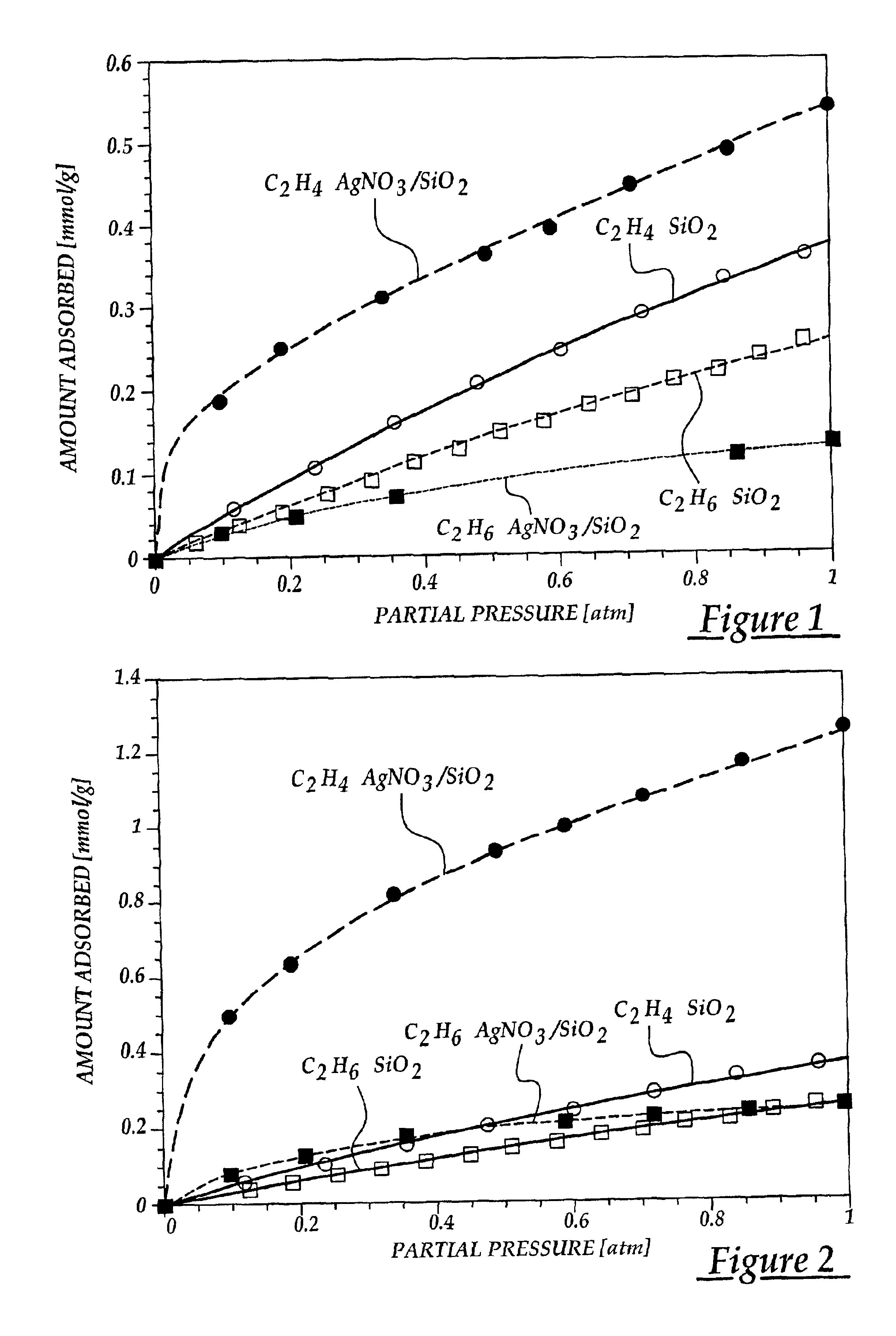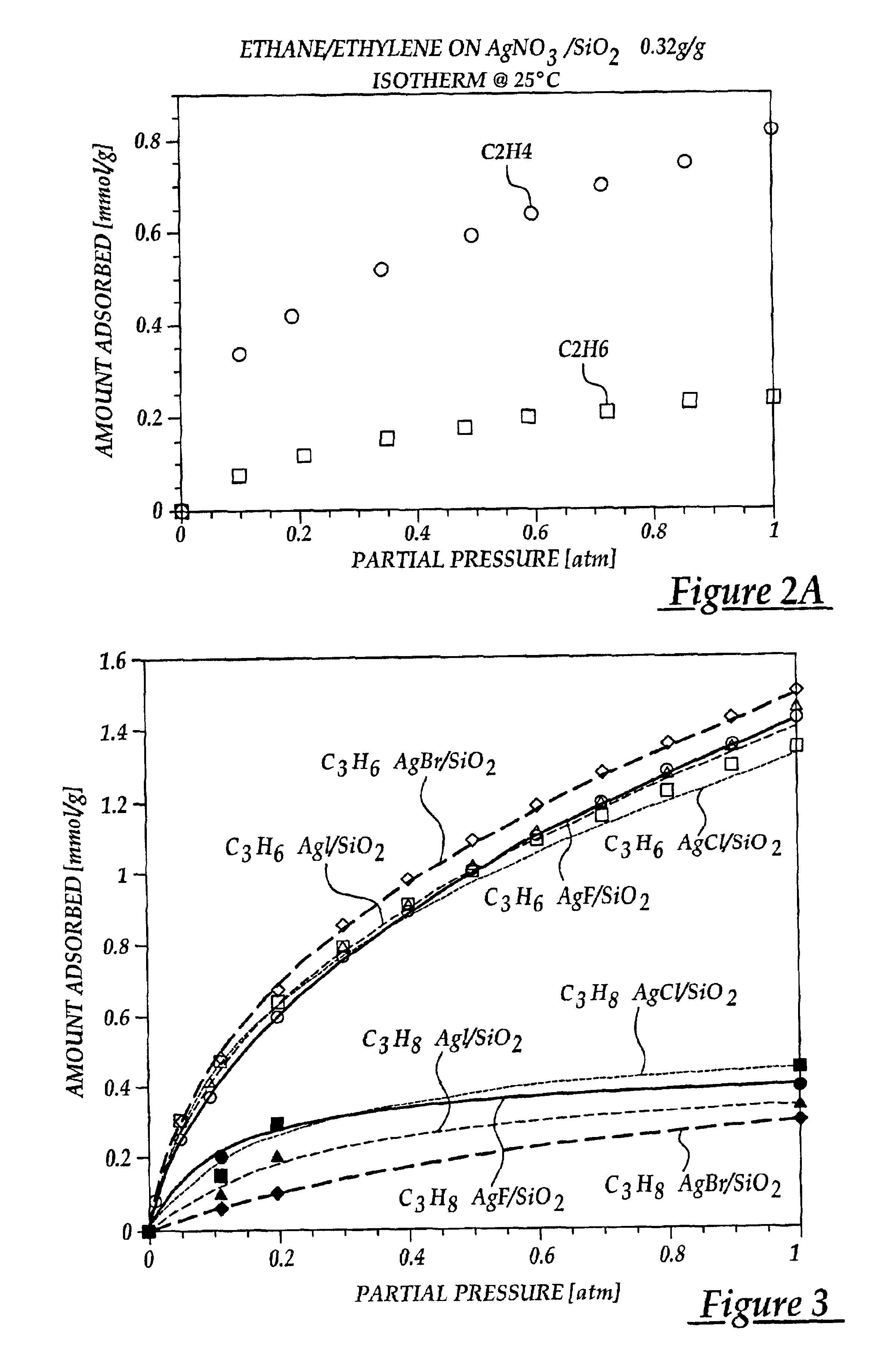Selective adsorption of alkenes using supported metal compounds
a technology of metal compounds and selective adsorption, which is applied in the direction of organic compounds/hydrides/coordination complex catalysts, physical/chemical process catalysts, other chemical processes, etc., can solve the problems of high capital costs and high operational costs of any cryogenic distillation approach, difficult to conduct methods, and difficult to adapt to commercial us
- Summary
- Abstract
- Description
- Claims
- Application Information
AI Technical Summary
Benefits of technology
Problems solved by technology
Method used
Image
Examples
example 1
AgNO3 Supported on SiO2 Prepared by Thermal Monolayer Dispersion and Incipient Wetness Impregnation
The sorbents of the invention are metal compounds which contain metal cations dispersed over a high surface area substrate. The dispersion of metal compounds and their included cations was accomplished using several methods. This was done to determine which technique was better suited for preparing π-complexation sorbents. One of the methods is known as spontaneous thermal monolayer dispersion. The other technique utilized was incipient wetness impregnation. Here, these techniques were applied to synthesize sorbents capable of π-complexation with olefins.
Thermal monolayer dispersion involves mixing a metal compound, preferably a metal salt, with a substrate at a predetermined ratio. This ratio is determined by the amount of salt that is required for monolayer coverage on the surface area of the substrate assuming two-dimensional close-packing. The BET surface area of the substrate was ...
example 2
Anion Effects—Ag-Halide Compounds Supported on SiO2
In this example, the effect of various anions on olefin adsorption is shown. By understanding this effect, the adsorptive properties of sorbents are maximized for olefin / paraffin separation. The sorbents were prepared by dispersing silver halides on silica gel via thermal monolayer dispersion. Incipient wetness impregnation was not used due to lack of good solvents. The halides used were AgF, AgCl, AgBr, and AgI. The silver halide content of each sorbent was maintained at around 1.0 mmol / g to facilitate comparison. The sorbents were prepared by mixing the metal halide and the silica gel with thorough mixing. The resulting mixture was heated in air at 350° C. for 4 days to assure proper spreading. The BET surface areas of the resulting sorbents are shown in Table B.
Equilibrium isotherms for C3H6 at 25° C. on the various AgX / SiO2 (where X=F, Cl, Br, or I) sorbents are shown in FIG. 3. The fitting parameters for these isotherms are sh...
example 3
Substrate Effects—AgNO3 Supported on λAl2O3, SiO2 and Zeolite
In order to gain a better understanding of the behavior of π-complexation sorbents, it is necessary to also understand the effects of various substrates on olefin adsorption. This example shows the effect that the chemical and structural properties of the substrate had on adsorption behavior. To this end, several sorbents were prepared by dispersing AgNO3 over three different high surface area substrates using the incipient wetness impregnation technique described previously. The substrates used were γ-Al2O3, SiO2 and MCM-41 mesoporous zeolite. The MCM-41 utilized is one of a new family of mesoporous silicate molecular sieves with hexagonal arrangement of unidimensional channels with uniform sizes in the range of 20-100 Å (Kresge, et al., 1992; Beck et al., 1992). The MCM-41 utilized had a BET surface area of 1004 m2 / g and an average pore size measured by the Horvath Kawazoe method to be 30 Å. The γ-Al2O3 utilized was obta...
PUM
| Property | Measurement | Unit |
|---|---|---|
| size | aaaaa | aaaaa |
| BET surface area | aaaaa | aaaaa |
| temperature | aaaaa | aaaaa |
Abstract
Description
Claims
Application Information
 Login to View More
Login to View More - R&D
- Intellectual Property
- Life Sciences
- Materials
- Tech Scout
- Unparalleled Data Quality
- Higher Quality Content
- 60% Fewer Hallucinations
Browse by: Latest US Patents, China's latest patents, Technical Efficacy Thesaurus, Application Domain, Technology Topic, Popular Technical Reports.
© 2025 PatSnap. All rights reserved.Legal|Privacy policy|Modern Slavery Act Transparency Statement|Sitemap|About US| Contact US: help@patsnap.com



